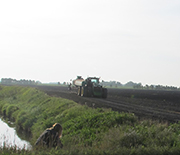News Release 18-007
Study shows wetlands provide landscape-scale reduction in nitrogen pollution
"Wetland complexes" in a watershed are very effective in reducing nitrate

Wetlands are important for reducing excess nitrate flowing downstream.
January 29, 2018
This material is available primarily for archival purposes. Telephone numbers or other contact information may be out of date; please see current contact information at media contacts.
Find related stories on NSF's Environmental Research and Education (ERE) programs at this link.
In agricultural regions such as the U.S. Midwest, excess nitrate from crop fertilizer makes its way into rivers and streams through subsurface drainage channels and agricultural ditches.
High nitrate concentrations in waterways can be harmful to ecosystems and human health, contaminating drinking water and eventually flowing downstream far enough to increase the size of the Gulf of Mexico's "dead zone."
A study published today in the journal Nature Geoscience by National Science Foundation (NSF)-funded researchers offers new insights into this problem: Multiple wetlands, or "wetland complexes" in a watershed, are extremely effective at reducing nitrate levels in rivers and streams.
Wetland complexes can be five times better at reducing nitrate than the best land-based nitrogen mitigation strategies, the scientists say.
"Agricultural productivity benefits the economy, but is often accompanied by environmental costs," says Tom Torgersen, director of NSF's Water, Sustainability and Climate program, which funded the research. "This study demonstrates that retaining or restoring wetlands in intensively managed agricultural watersheds would reduce nitrate in rivers and improve local water quality, while also reducing nitrate exports to the Gulf of Mexico hypoxic [dead] zone."
Using water samples collected over a four-year period from more than 200 waterways in the 17,000-square-mile Minnesota River Basin (MRB), along with geospatial information on land use in the MRB watershed, researchers isolated the effects of wetlands on stream and river nitrate concentrations.
The research produced a number of significant findings:
- When stream flows are high, wetlands are five times more efficient at reducing nitrate than the best land-based conservation practices.
- The arrangement of wetlands in a watershed is a predictor of the magnitude of nitrate reduction. When wetlands filter runoff from 100 percent of a drainage area, they are three times more effective at nitrate removal than when they filter runoff from 50 percent of a drainage area.
- Nitrate reduction in temporary wetlands and in geographically isolated wetlands (those not connected to a river), such as wetlands that form in agricultural ditches, is largest during high stream flows.
"These are important steps toward recognizing that as we lose wetlands, we also lose the significant benefits they provide in pollution control," says Amy Hansen, a researcher at the University of Minnesota's St. Anthony Falls Laboratory and first author of the journal paper.
The contributions of small wetlands are especially important for the future, Hansen says. Climate forecasts predict increases in precipitation frequency and magnitude -- conditions under which wetlands play a significant role in reducing river nitrate.
"Our work shows that wetland restoration could be one of the most effective methods for improving water quality in the face of climate change and the increasing global demand for food," says paper co-author Jacques Finlay, an ecologist at the University of Minnesota.
Other co-authors of the paper are Christine Dolph of the University of Minnesota and Efi Foufoula-Georgiou of the University of California, Irvine.
The results of the research are advancing scientists' understanding of wetlands and their role in pollution control, according to the researchers, and providing guidance on wetland restoration siting and benefits.
-NSF-
-
Agricultural ditch with a field of corn on one side and soybeans on the other.
Credit and Larger Version -
Scientists measure water velocity in ditch
Credit and Larger Version -
Researchers collect water samples for chemical analyses of nitrate concentration.
Credit and Larger Version -
Ecologists collect water samples from an agricultural ditch as a field is readied for planting.
Credit and Larger Version -
Swans rest in a flooded, farmed depression.
Credit and Larger Version
Media Contacts
Cheryl Dybas, NSF, (703) 292-7734, email: cdybas@nsf.gov
Barbara Heitkamp, UMN, (612) 626-6166, email: bkb0811@umn.edu
The U.S. National Science Foundation propels the nation forward by advancing fundamental research in all fields of science and engineering. NSF supports research and people by providing facilities, instruments and funding to support their ingenuity and sustain the U.S. as a global leader in research and innovation. With a fiscal year 2023 budget of $9.5 billion, NSF funds reach all 50 states through grants to nearly 2,000 colleges, universities and institutions. Each year, NSF receives more than 40,000 competitive proposals and makes about 11,000 new awards. Those awards include support for cooperative research with industry, Arctic and Antarctic research and operations, and U.S. participation in international scientific efforts.
Connect with us online
NSF website: nsf.gov
NSF News: nsf.gov/news
For News Media: nsf.gov/news/newsroom
Statistics: nsf.gov/statistics/
Awards database: nsf.gov/awardsearch/
Follow us on social
Twitter: twitter.com/NSF
Facebook: facebook.com/US.NSF
Instagram: instagram.com/nsfgov





